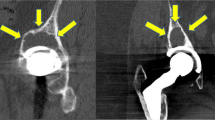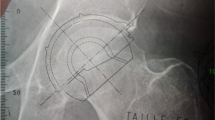Abstract
Background
The Zimmer-Explant system has made removal of a well-fixed monobloc acetabular component less challenging, but depends on the presence of an intact liner for instrument centralization. We report the outcome of 15 hips with well-fixed, cementless resurfacing sockets, which were removed using a modification of the existing method. We conclude that the existing Explant system combined with modular trial heads allows safe removal of monobloc shells with minimal bone loss.
Methods
Fifteen patients who underwent removal of a well-fixed, acetabular resurfacing component at the time of revision arthroplasty were identified from the unit’s prospective arthroplasty database from 2005.
Result
The final reamer used during reconstruction was only 1 or 2 mm larger than the outer diameter of the revised cup.


Similar content being viewed by others
References
Ranawat CS, Peters LE, Umlas ME, Dorr LD (1996) Optimal fixation for acetabular components: the case for cement versus cementless bone ingrown modular sockets. J Arthroplasty 11:1–6
Letournel E (1987) Non-cemented hip implants: failures of biologically fixed devices: causes and treatment. Hip 318–350
Mitchell PA, Masri BA, Garbuz DS, Greidanus NV, Wilson D, Duncan CP (2003) Removal of well-fixed, cementless, acetabular components in revision hip arthroplasty. J Bone Joint Surg Br 85(7):949–952
Udomkiat P, Wan Z, Dorr LD (2001) Comparison of preoperative radiographs and intraoperative findings of fixation of hemispheric porous coated sockets. J Bone Joint Surg A 83:1865–1870
Sibanda N, Copley LP, Lewsey JD, Borroff M, Gregg P, MacGregor AJ, Pickford M, Porter M, Tucker K, van der Meulen JH, Steering Committee of the National Joint Registry (NJR) for England and Wales (2008) Revision rates after primary hip and knee replacement in England between 2003 and 2006. PLoS Med 5(9):e179
Mallory TH, Lombardi AV, Fada RA et al (2000) Noncemented acetabular component removal in the presence of osteolysis: the affirmative. Clin Orthop 381:120–128
Anspach WE III, Lachiewicz PF (1991) A new technique for removal of the total hip arthroplasty acetabular component. Clin Orthop 268:152–156
Lachiewicz PF, Anspach WE III (1991) Removal of a well fixed acetabular component: a brief technical note of a new method. J Bone Joint Surg A [Am] 73:1355–1356
Daum WJ, Calhoun JH (1988) Removal of the acetabular component minimizing destruction of the bone bed. J Arthroplasty 3:379–380
Pierson JL, Jasty M, Harris WH (1993) Techniques of extraction of well fixed cemented and cementless implants in revision total hip arthroplasty. Orthop Rev 22:904–916
D’Antonio JA, Capello WN, Borden LS et al (1989) Classification and management of acetabular abnormalities in total hip arthroplasty. Clin Orthop 243:126–137
Maloney WJ (2000) Socket retention: staying in place. Orthopedics 23:965–966
Olyslaegers C, Wainwright T, Middleton RG (2008) A novel technique for the removal of well-fixed cementless, large-diameter metal-on-metal acetabular components. J Arthroplasty 23(7):1071–1073
Conflict of interest
The authors declare that they have no conflict of interest.
Author information
Authors and Affiliations
Corresponding author
Rights and permissions
About this article
Cite this article
Preiss, R.A., Patil, S. & Meek, R.M.D. The use of modular femoral head trials to centre the Explant blade facilitates retrieval of well-fixed acetabular components with minimal bone loss. Arch Orthop Trauma Surg 131, 1003–1006 (2011). https://doi.org/10.1007/s00402-010-1229-6
Received:
Published:
Issue Date:
DOI: https://doi.org/10.1007/s00402-010-1229-6




